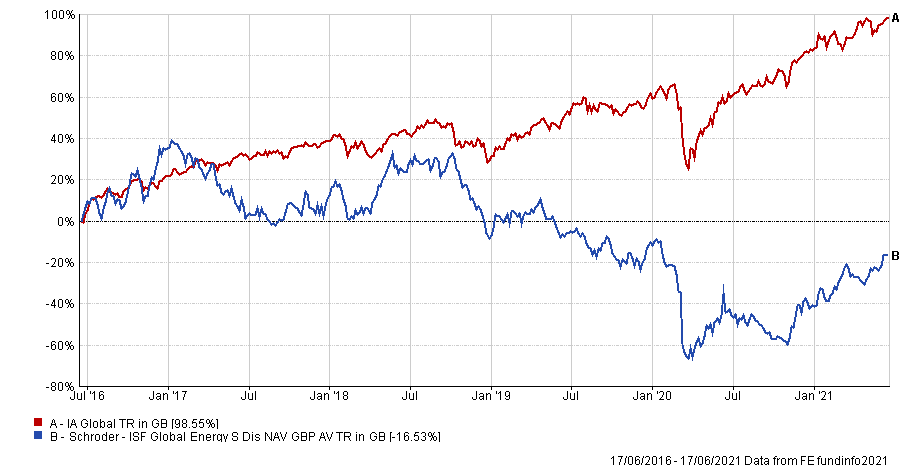The oil market is experiencing a “vicious circle”, according to Schroders’ Mark Lacey, as companies are caught between a rising demand for oil and an unwillingness to back long-term oil projects as renewable energy moves in.
Lacey, manager of the Schroder ISF Global Energy fund, which is the top performing active fund in the IA Global sector year-to-date, explained that after recovering from a rock bottom crash last year the price oil could still move higher.
He noted that demand for oil has still not fully returned to pre-pandemic levels as the travel industry, and air travel in particular, remain largely grounded. Air travel makes up 10 per cent of the global oil demand.
“You can use really simple round numbers – it's about 100 million barrel a day oil market. And aviation is about 10 per cent of that,” the manager said.
“At the height of the pandemic, we had aviation down 70 per cent year on year. That's how bad it got because no one was getting on a plane and all you had was goods transportation being managed at that point. Your oil market demand has shrunk to 93 million barrels a day, then you had also goods, transportation and everything like that all slowed considerably.
“And obviously, energy usage slowed. So you got down to less than 90 million barrels a day and that's the worst demand shock ever in the history of oil.
“What's happened [now] is you've had this massive policy shift through near death experience for a lot of the companies. Basically, they're not willing to grow production a lot anymore, because they see these energy transition pressures with regards to demand.”
There has been a significant push into using more renewable energy over traditional oil & natural gas sources as climate change worsens. Governments have also been pushing to support this with renewed vigour on various carbon reduction targets and fiscal support for renewable energy providers.
As oil & gas companies face a future where their product is in lower demand and they need to transition themselves, they’re unwilling to reinvestment into the fossil fuel elements of their business or sanction new long-term projects.
Lacey added: “So you have this really strange period between now and 2028 where the oil market still has increasing demand dynamics, because your energy transition doesn't happen overnight.
“But at the same time oil companies don't want to basically put new projects into the market. That's going to put upward pressure on the oil price, because recently the major oil companies are starting to accelerate their change towards energy transition spaces. It's a vicious circle.
“More free cash flow coming from higher oil prices, more free cash flow coming from high gas prices, and diverting that into the renewable space they're not reinvesting. You've got what is effectively a supply versus demand squeeze.”
Applying this to his own Schroder ISF Global Energy fund, Lacey said it would continue with its mid-cap bias, only investing in companies with really strong balance sheets and similarly high returns focus along with having “adaptive business models”. By this, Lacey explained these are companies which have exposure to both the oil & gas market as well as the renewables “new market”.
As mentioned earlier, the Schroder ISF Global Energy fund has been the top performing active fund in the IA Global sector in 2021, making a total return of 31.82 per cent.
The $401.8m fund does however have the worst 10-year cumulative volatility of the entire sector, at 36.11 per cent. The MSCI World/Energy benchmark had, by comparison, volatility of 21.21 per cent.
“Just as it used to frustrate me when the oil price had collapsed. Just as the oil price collapsed in previous years, Brent has gone from $120 a barrel it got down to $10 a barrel and it went negative and people were saying ‘why has your energy fund underperformed?’” he said.
“And you think ‘well what am I supposed to do be invested in Tesla or Google as an alternative?’ You know, we have to invest in that asset class, unfortunately.”
Focusing on the positive run in 2021, Lacey explained that this was largely down to the operating leverage against the underlying commodity price.
“The industry can produce crude on a cash basis around about $35 to $40 a barrel. When the oil price goes through $40 a barrel roughly, that's when the industry is losing money,” he explained.
“When the oil price goes from $40 to $50 you're making $10 a barrel. When the oil price goes from $50 to $60, you're making $20 a barrel. So how much is your profit grown by when your price has gone up by just $10 a barrel? The oil price goes up by 20 per cent but how much has the corporate’s profit grown by? 100 per cent. If your previous profit was $10 a barrel over the $40 and it goes to $60 you’re making $20 a barrel profit.
“And it's that leverage to the oil price and the gas price, that leverage to those underlying commodity prices, which is underestimated on the way down, particularly by the broader market. And there's massively underestimated on the way back up.
“Because you've got so much operating leverage. That is the thing that people think ‘why are you exposed to the oil price shouldn’t you just track the oil price?’ Absolutely not. You track the oil price, firstly, at an inflection point in terms of profitability and it is the expansion of profitability from that point that share prices basically have leveraged to the oil price.”
Performance of fund vs sector over 5yrs

Source: FE Analytics
Over the past five years Schroder ISF Global Energy has made a loss of 16.53 per cent, underperforming the IA Global sector which returned 98.55 per cent during that time.
The fund has an ongoing charges figure (OCF) of 0.80 per cent.





